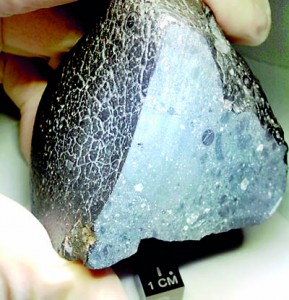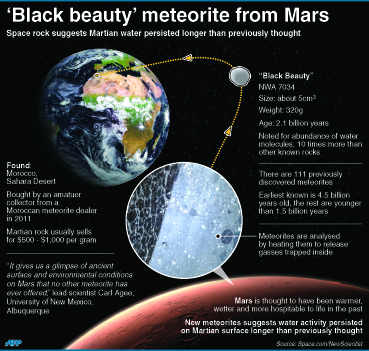Sunday Times 2
‘Black Beauty’ could yield Martian secrets
View(s):2 Billion year old cricket ball sized meteorite filled with ancient water from Mars
WASHINGTON (AFP) – A fist-sized meteorite nicknamed “Black Beauty” could unlock vital clues to the evolution of Mars from the warm and wet place it once was to its current cold and dry state, NASA said Thursday.
Discovered in Morocco’s Sahara Desert in 2011, the 11-ounce (320-gram) space rock contains 10 times more water than other Martian meteorites and could be the first ever to have originated on the planet’s surface or crust.

A fist-sized meteorite nicknamed "Black Beauty", which could unlock vital clues to the evolution of Mars (AFP)
After more than a year of intensive study, a team of US scientists determined the meteorite formed 2.1 billion years ago during the beginning of the most recent geologic period on Mars, known as the Amazonian, NASA said.
The abundance of water molecules in the meteorite — about 6,000 parts per million, 10 times more than other known rocks — suggests water activity persisted on the Martian surface when it was formed.
It is generally accepted that Mars had abundant water early in its existence — scientists ponder if life might once have existed there — but the nature of its evolution to a cold and dry place remains a mystery.
 “Many scientists think that Mars was warm and wet in its early history, but the planet’s climate changed over time,” lead scientist Carl Agee, whose study was published in “Science Express,” told Space.com.
“Many scientists think that Mars was warm and wet in its early history, but the planet’s climate changed over time,” lead scientist Carl Agee, whose study was published in “Science Express,” told Space.com.
Known technically as NWA (Northwest Africa) 7034, “Black Beauty” is made of cemented fragments of basalt, a rock that forms from rapidly cooled lava.
“Perhaps most exciting is that the high water content could mean there was an interaction of the rocks with surface water either from volcanic magma, or from fluids from impacting comets during that time,” co-author Andrew Steele said.
“It is the richest Martian meteorite geochemically and further analyses are bound to unleash more surprises.”
Unlike most Martian meteorites, it is thought to be from the planet’s surface, not deeper inside, as its chemistry matched surface rocks NASA has studied remotely via Mars rovers and orbiting satellites.
More than 100 Martian meteorites have been discovered on Earth to date but most come from three meteorites: Shergotty, Nakhla, and Chassigny. NWA 7034 has unique characteristics and it took scientists several months to ascertain that it did indeed come from Mars and not another planet, or from an asteroid belt.
“The age of NWA 7034 is important because it is significantly older than most other Martian meteorites,” said Mitch Schulte, program scientist for the Mars Exploration Program at NASA headquarters in Washington.
“We now have insight into a piece of Mars’ history at a critical time in its evolution.”
Follow @timesonlinelk
comments powered by Disqus



















